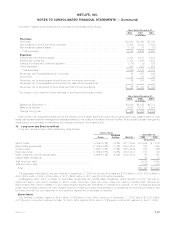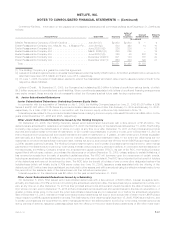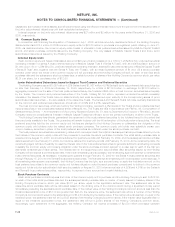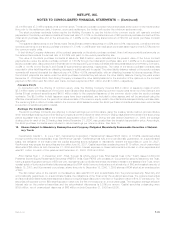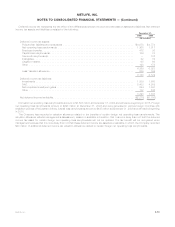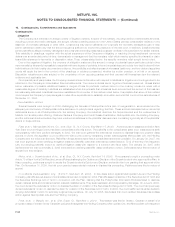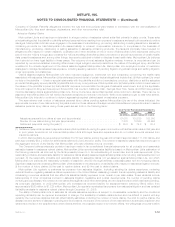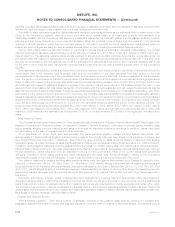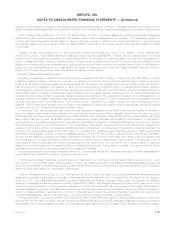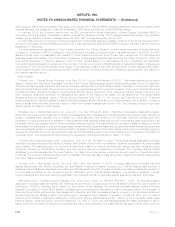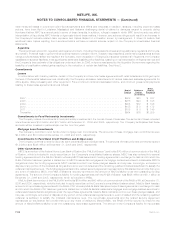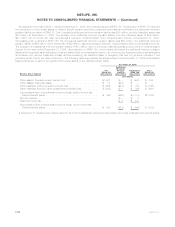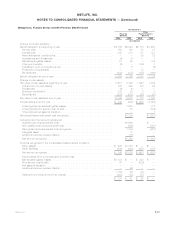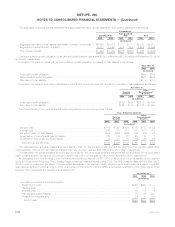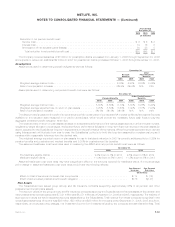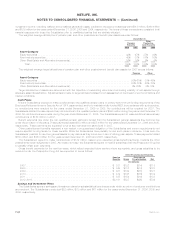MetLife 2006 Annual Report Download - page 137
Download and view the complete annual report
Please find page 137 of the 2006 MetLife annual report below. You can navigate through the pages in the report by either clicking on the pages listed below, or by using the keyword search tool below to find specific information within the annual report.plaintiffs to pursue claims against Metropolitan Life when exposure to asbestos took place after the dangers of asbestos exposure were
well known, and the impact of any possible future adverse verdicts and their amounts.
The ability to make estimates regarding ultimate asbestos exposure declines significantly as the estimates relate to years further in the
future. In the Company’s judgment, there is a future point after which losses cease to be reasonably probable and estimable. It is
reasonably possible that the Company’s total exposure to asbestos claims may be materially greater than the asbestos liability currently
accrued and that future charges to income may be necessary. While the potential future charges could be material in the particular
quarterly or annual periods in which they are recorded, based on information currently known by management, management does not
believe any such charges are likely to have a material adverse effect on the Company’s consolidated financial position.
During 1998, Metropolitan Life paid $878 million in premiums for excess insurance policies for asbestos-related claims. The excess
insurance policies for asbestos-related claims provide for recovery of losses up to $1.5 billion, which is in excess of a $400 million self-
insured retention. The asbestos-related policies are also subject to annual and per-claim sublimits. Amounts are recoverable under the
policies annually with respect to claims paid during the prior calendar year. Although amounts paid by Metropolitan Life in any given year
that may be recoverable in the next calendar year under the policies will be reflected as a reduction in the Company’s operating cash flows
for the year in which they are paid, management believes that the payments will not have a material adverse effect on the Company’s
liquidity.
Each asbestos-related policy contains an experience fund and a reference fund that provides for payments to Metropolitan Life at the
commutation date if the reference fund is greater than zero at commutation or pro rata reductions from time to time in the loss
reimbursements to Metropolitan Life if the cumulative return on the reference fund is less than the return specified in the experience
fund. The return in the reference fund is tied to performance of the Standard & Poor’s 500 Index and the Lehman Brothers Aggregate Bond
Index. A claim with respect to the prior year was made under the excess insurance policies in each of 2003, 2004, 2005 and 2006 for the
amounts paid with respect to asbestos litigation in excess of the retention. As the performance of the indices impacts the return in the
reference fund, it is possible that loss reimbursements to the Company and the recoverable amount with respect to later periods may be
less than the amount of the recorded losses. Foregone loss reimbursements may be recovered upon commutation depending upon future
performance of the reference fund. If at some point in the future, the Company believes the liability for probable and reasonably estimable
losses for asbestos-related claims should be increased, an expense would be recorded and the insurance recoverable would be adjusted
subject to the terms, conditions and limits of the excess insurance policies. Portions of the change in the insurance recoverable would be
recorded as a deferred gain and amortized into income over the estimated remaining settlement period of the insurance policies. The
foregone loss reimbursements were approximately $8.3 million with respect to 2002 claims, $15.5 million with respect to 2003 claims,
$15.1 million with respect to 2004 claims, $12.7 million with respect to 2005 claims, and estimated to be approximately $5.0 million with
respect to 2006 claims and are estimated, as of December 31, 2006, to be approximately $72.2 million in the aggregate, including future
years.
Sales Practices Claims
Over the past several years, Metropolitan Life, New England Mutual Life Insurance Company (“New England Mutual”), New England Life
Insurance Company and General American Life Insurance Company (“General American”), have faced numerous claims, including class
action lawsuits, alleging improper marketing and sales of individual life insurance policies or annuities. In addition, claims have been
brought relating to the sale of mutual funds and other products.
As of December 31, 2006, there were approximately 280 sales practices litigation matters pending against Metropolitan Life;
approximately 41 sales practices litigation matters pending against New England Mutual, New England Life Insurance Company and
New England Securities Corporation (collectively, “New England”); approximately 37 sales practices litigation matters pending against
General American; and approximately 20 sales practices litigation matters pending against Walnut Street Securities, Inc. (“Walnut Street”).
In addition, similar litigation matters are pending against MetLife Securities, Inc. (“MSI”). Metropolitan Life, New England, General American,
MSI and Walnut Street continue to vigorously defend against the claims in these matters. Some sales practices claims have been resolved
through settlement, others have been won by dispositive motions or have gone to trial. Most of the current cases seek substantial
damages, including in some cases punitive and treble damages and attorneys’ fees. Additional litigation relating to the Company’s
marketing and sales of individual life insurance, mutual funds and other products may be commenced in the future.
Two putative class action lawsuits involving sales practices claims were filed against Metropolitan Life in Canada. In Jacynthe Evoy-
Larouche v. Metropolitan Life Ins. Co. (Que. Super. Ct., filed March 1998), plaintiff alleges misrepresentations regarding dividends and
future payments for life insurance policies and seeks unspecified damages. In Ace Quan v. Metropolitan Life Ins. Co. (Ont. Gen. Div., filed
April 1997), plaintiff alleges breach of contract and negligent misrepresentations relating to, among other things, life insurance premium
payments and seeks damages, including punitive damages. By agreement of the parties, Metropolitan Life has not yet filed a response in
this action.
Regulatory authorities in a small number of states have had investigations or inquiries relating to Metropolitan Life’s, New England’s,
General American’s, MSI’s or Walnut Street’s sales of individual life insurance policies or annuities or other products. Over the past several
years, these and a number of investigations by other regulatory authorities were resolved for monetary payments and certain other relief.
The Company may continue to resolve investigations in a similar manner. The Company believes adequate provision has been made in its
consolidated financial statements for all probable and reasonably estimable losses for sales practices claims against Metropolitan Life,
New England, General American, MSI and Walnut Street.
Property and Casualty Actions
Katrina-Related Litigation. There are a number of lawsuits, including a few putative class actions, pending in Louisiana and,
Mississippi against Metropolitan Property and Casualty Insurance Company (“MPC”) relating to Hurricane Katrina. The lawsuits include
F-54 MetLife, Inc.
METLIFE, INC.
NOTES TO CONSOLIDATED FINANCIAL STATEMENTS — (Continued)



